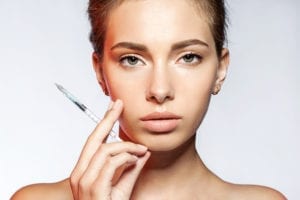
Since Dr. Kearney offers various options for both types of these injectables, here’s some information to clear up any misunderstanding.
Neuromodulator 101
The name gives these injectables away. It sounds like something to do with the nerves, and it is. You can think of “neuromodulator” as a fancy term for the muscle relaxer. The goal of these products is to stop a particular muscle from contracting. It does this by inhibiting the nerve communication, the reason these injectables are named neuromodulators.
Neuromodulators are all about the wrinkles that are caused when we make certain facial expressions such as squinting or frowning. These expressions are formed mainly by the upper third of the face. Try it. Squint and feel the muscles of your forehead contract and create lines and wrinkles. When these muscles contract, they create a wrinkle on the surface skin.
Neuromodulators are made from the botulinum toxin type A. Yes, that is the very same bacteria that cause botulism. During WWII research on this toxin showed that when it was injected in very miniscule amounts into a muscle the toxin temporarily stopped the muscle from contracting. They found that the botulinum toxin blocked the nerve in the muscle from sending a message to the brain to contract the muscle. Without the message, the brain didn’t send out the word to contract the muscle. Botox was born.
Botox was originally approved to address things such as involuntary eyelid spasms, where the patient can’t control a certain muscle. Then in 2002, the FDA approved it for the treatment of facial wrinkles such as crow’s feet and the 11s (the lines between the eyebrows). The rest is history, as Botox is now one of the world’s most famous brand names and is a year in and year out the world’s most performed cosmetic procedure.
Dr. Kearney offers the neuromodulators Botox and Dysport.
Dermal filler 101
Now dermal fillers. Dr. Kearney uses a variety of dermal fillers, everything from Juvederm to Sculptra. A dermal filler is true to its name — it fills the wrinkle from beneath. When skin is sun damaged or has lost volume, there is a depression on the skin surface. This can be a wrinkle or a depressed area such as the cheeks. Dermal fillers are injected directly beneath the wrinkle or area with decreased volume. The filler “fills” space and pushes the skin back upward, erasing the wrinkle and filling volume.
Dermal fillers are either “natural” or “synthetic.” Natural fillers such as Juvederm and Restylane are comprised primarily of hyaluronic acid. Hyaluronic acid is a naturally occurring substance in humans that is responsible for keeping the skin hydrated and plump. It does this by binding with water molecules under the skin’s surface.
Synthetic fillers are made of synthetic materials. Sculptra, for instance, contains poly-L-lactic acid that triggers the body to produce collagen, which returns structural support to the skin, eliminating wrinkles and lines. Bellafill contains polymethyl methacrylate microspheres that add a structural framework that supports the skin above. It also triggers collagen production.
Dr. Kearney uses both Sculptra and Bellafill, along with other dermal fillers.
Now that you’re an injectable expert, do you have some areas of your face that could use them? Call Dr. Kearney at (858) 677-9352 and let’s see which could work for you.

